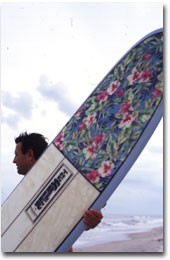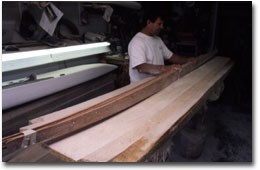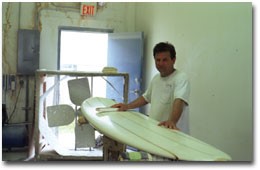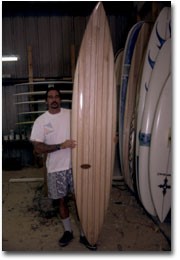George Robinson: Surfboard Maker
By Robert L. Stone
 In his small shop in an industrial park in Melbourne, George Robinson puts the finishing touches on a beautifully crafted, sleek, nine-and-a-half-foot surfboard. Using his two hands, a few simple tools, and knowledge gained through thirty years of experience, he has joined balsa wood from Ecuador and redwood from California to create the functional work of art he will ship to Australia. Working as a master surfboard shaper in south and central Florida, Robinson has fashioned an estimated 1,200 such balsa boards and more than 7,000 polyurethane foam boards. He enjoys an international reputation as one of the finest makers of balsa surfboards. Robinson is one of only a handful of craftsmen who still painstakingly fashion surfboards from the feather-light wood. He makes only a few dozen balsa boards per year, each expertly hand-crafted to the client's specifications.
In his small shop in an industrial park in Melbourne, George Robinson puts the finishing touches on a beautifully crafted, sleek, nine-and-a-half-foot surfboard. Using his two hands, a few simple tools, and knowledge gained through thirty years of experience, he has joined balsa wood from Ecuador and redwood from California to create the functional work of art he will ship to Australia. Working as a master surfboard shaper in south and central Florida, Robinson has fashioned an estimated 1,200 such balsa boards and more than 7,000 polyurethane foam boards. He enjoys an international reputation as one of the finest makers of balsa surfboards. Robinson is one of only a handful of craftsmen who still painstakingly fashion surfboards from the feather-light wood. He makes only a few dozen balsa boards per year, each expertly hand-crafted to the client's specifications.
Surf's Up
Surfing was developed centuries ago in the Pacific Islands. Hawaiians used very large boards, often more than 200 pounds in weight and up to eighteen feet in length. They crafted the boards from solid native hardwoods, like koa and ulu. In the first half of the twentieth century Californian surfboard makers used redwood to make surfboards that closely resembled Hawaiian designs. As the sport grew, both in the mainland and Hawaii, surfboard makers developed shorter, lighter boards that responded more quickly. This design allowed surfers to execute more sophisticated maneuvers. The lighter boards were also safer because they carried less force when driven by a powerful wave to strike a fallen surfer. Today the most popular surfboards measure about 6 ½ feet and are made from polyurethane foam covered with a fiberglass and resin laminate.
Although "longboards" measuring about 9 ½ feet were still made, they faded from general use as the shorter boards became more popular during the 1970s. A revival of interest in longboards began during the mid-1990s and continues to grow into the new millennium. Though many younger surfers enjoy longboards, the interest comes primarily from baby boomer surfers who prefer longboards because they are easier to ride and can support the extra weight those surfers have acquired over the years.
Florida surfing has a relatively brief but interesting history. In 1936 Bill Whitman of Miami Beach fashioned the first Florida-made surfboard from sugar pine. The board was a ten-footer built in the Hawaiian style. His brother, Dudley, made a similar board out of spruce when he was just thirteen years old. Soon after completing his heavy spruce board, Dudley saw surfboard innovator Tom Blake paddling effortlessly on a hollow surfboard. He got a set of plans from a hobby magazine and created his own hollow board. The Blake design was similar to an aircraft wing; a thin wooden skin covering a structure of wooden plates and ribs. The Whitman brothers continued to surf and popularize the sport at Daytona Beach while they attended the University of Florida in Gainesville. By the end of World War II, surfing became a staple of Daytona Beach life and the sport began to spread rapidly throughout coastal Florida.
Surfing began to boom in post-World War II California, and it exploded as a sport and lifestyle during the 1960s. The popularity of surfing and surf culture rapidly spread to the East Coast, and the sport continued to grow in Florida. Today, the realm of surfing includes a complete culture as well as the actual sport. Over the years surfers have developed their own jargon, visual art forms, music, and apparel, and other cultural elements.
 Although California and Hawaii are the primary states associated with surfing, Florida is a major force in the sport. Many outstanding surfers are Floridians. For example, Kelly Slater of Cocoa Beach is the only person to win the world championship six times. In addition, there are a number of world-class surfboard makers located in the state. East Coast surfers now outnumber those on the West Coast, and Florida is the leading surfing state in the east.
Although California and Hawaii are the primary states associated with surfing, Florida is a major force in the sport. Many outstanding surfers are Floridians. For example, Kelly Slater of Cocoa Beach is the only person to win the world championship six times. In addition, there are a number of world-class surfboard makers located in the state. East Coast surfers now outnumber those on the West Coast, and Florida is the leading surfing state in the east.
What makes Florida surfing so attractive? Floridians can surf year round and Florida surfing spots are not as crowded as they are in Hawaii and California. In those states, crowded conditions in popular areas not only makes surfing more dangerous, but experienced surfers may also treat novices with hostility. The gentler Florida waves provide an easy place to learn. Moreover, the high cost of living in California and Hawaii is prohibitive for many surfers. Although Florida surf is generally smaller than that of the West Coast, big waves reach the Sunshine State during the summer and fall tropical storm season. The twenty-foot waves that pounded the central coast during the Halloween swell of 1991, for example, are legendary among Florida surfers.
George Robinson
George Robinson was born 1953, and grew up in the south Florida suburb of Miramar. He participated in water sports from an early age. His father was an avid diver, so George began skin diving when he was about six years old and had his own scuba equipment by the time he was ten. In his early teens Robinson and many of his peers were attracted to the image and life style of surfing, which had spread from California to the East Coast through recordings by the Beach Boys and other groups, surfing and beach party movies, and surfing magazines. In the spring of 1966 he began to surf in the calm Atlantic waters off south Florida beaches near his home.
Robinson and his sister spent the summer of 1966 with paternal relatives who lived near Guyaquil on the coast of Ecuador. In Ecuador, he surfed in the Pacific Ocean on locally made balsa longboards. Rides on the world class waves lasted up to five minutes per wave-quite a thrill compared to the five or ten second rides which were the norm in south Florida. As a result of his summer surfing in Ecuador, young Robinson became even more enthusiastic. In 1968, while a sophomore at McArthur High School, he started Florida's first high school surfing club.
Many young surfers try to make their own surfboards, but most realize the process is much more difficult than they had thought and quit after one or two attempts. Robinson began his experiments in surfboard making in 1970. He had a knack for grasping the principles necessary for good surfboards and was tenacious in his quest to master the craft. By 1972, with some minimal financial assistance from his father, he opened the Mar Bravo, or "big surf," sports and surf shop in Ecuador. He stocked the store with about fifty polyurethane surfboards he had made himself-quite an accomplishment for a seventeen-year-old.
Like most surfboard makers, Robinson learned his craft by combining practice with the observation and analysis of the techniques of successful builders. Robinson credits Johnny Rice, a renowned California shaper who was brought to Florida to make surfboards, as one of the major influences in his journey to becoming a master shaper.
Having family connections in Ecuador also proved beneficial as Robinson tried to establish his reputation as a surfboard maker. About ninety-seven percent of the world's balsa wood is produced in Ecuador. Robinson could buy the balsa directly from mills in Ecuador and his cousin, who owned an air cargo company, gave him free air freight. Thus, he was able to make balsa surfboard blanks in Florida at a cost competitive with polyurethane foam boards. Before he was twenty, he had achieved a reputation for making quality balsa longboards.
Like nearly all surfboard makers, Robinson is a lifelong surfer. Throughout the 1970s he actively engaged in competition, and in 1978 won the United States East Coast Championship. He was also a serious competitor in windsurfing. Today, Robinson's excellent physical condition and youthful enthusiasm belie his forty-seven years. He still surfs regularly and is planning a comeback in competitive surfing.
Making a Balsa Longboard
The process of creating a custom surfboard begins with a dialog between the maker and the prospective client. Factors they consider include the surfer's height and weight; the kind of surf in which the board will be used; overall board length; the shape of the nose and tail; the amount of "rocker," or arch along the length of the bottom of the board; the shape, placement and number of fins; the number of "stringers," or stiffeners; the type of wood used for the stringers; finish and decoration.
Robinson begins crafting a balsa longboard by gluing together several full length balsa boards, each averaging about four inches square and ten feet long.

He then rough shapes the surfboard using a hand-held electric planer. Whether the material is wood or foam, shaping is the most critical stage of surfboard making because the shape determines the performance characteristics of the board. "If the shape is no good, it ain't going to ride," quips Robinson.


After rough shaping, he cuts the surfboard along the length, between glue joints, into six or seven long pieces. He then carves away about twenty-five percent of the total mass of the balsa from the core of each piece. This "chambering" process considerably reduces the weight of the board with virtually no reduction in strength or stiffness. After chambering, Robinson glues the board back together, sandwiching 1/8" thick redwood or cedar stringers at a number of the new glue joints. The stringers give the board strength and the contrasting dark color of the redwood or cedar provide a pleasing design. He then performs the final shaping using rasps and sandpaper.
Every surfboard has one or more fins on the bottom to enable the surfer to steer the board. While most contemporary foam boards employ two or three smaller fins, Robinson usually fits one large fin to his boards in keeping with classic longboard design. Although Robinson uses a series of templates throughout the shaping process, it is his eyes and hands, guided by more than three decades of experience in making boards and surfing, that create the final shapes for which he is renowned.
The final step is coating the board with a laminate of light fiberglass and polyester resin and polishing it to a high gloss. The laminate adds greatly to the board's strength and provides a durable finish. This "glassing" is an exacting process that involves working with hazardous chemicals and highly volatile solvents. It is demanding and difficult work, usually performed by young men who are working their way up in the surfboard making business.

All foam boards are painted or have pigment mixed into the resin. Many custom foam boards have decorative designs incorporated just prior to or during the glassing process. The decoration may be as simple as monochromatic paint or pigmented resin or can involve any number of creative processes such as striping, decals, hand painted illustrations, inlaid textiles, and an endless variety of airbrush designs. Robinson's balsa board clients prefer an unadorned clear finish, which allows the natural beauty of the woods to be enjoyed. He glasses all his balsa boards himself, but like many expert surfboard shapers, he chooses to have his foam boards glassed and decorated by a contractor who specializes in the process. In this way, Robinson is able to enjoy a workplace minimally impacted by the chemical hazards, mess and odors associated with glassing.

The short, light polyurethane foam boards popular with most surfers today are fragile. Although such boards might cost several hundred dollars, they are essentially expendable items. It is not uncommon for an aggressive surfer to break several foam boards each year. Robinson's balsa longboards, however, are built to last a lifetime. Costing several times as much as a custom foam board, they can be viewed as lifetime investments. Many of his boards are purchased by wealthy clients, who use them to decorate homes or businesses.
By continuing to craft balsa longboards and custom-built foam surfboards with great expertise, Robinson helps ensure the future of surfing sport and culture in Florida. Like many surfers his age, he is a strong advocate of surfing as wholesome family sport. He has even begun to produce a line of surfboards specially designed for children. "It's no longer a party lifestyle," he asserts. "I see people my age taking their kids on surfing trips and vacations." His four-year-old son, Cristian, has already begun to surf. "He's too young to paddle out, but he can get up and surf," Robinson says with the smile of a proud father.
Bibliography
Vansant, Amy. The Surfer's Guide to Florida, Sarasota: Pineapple Press, 1995

